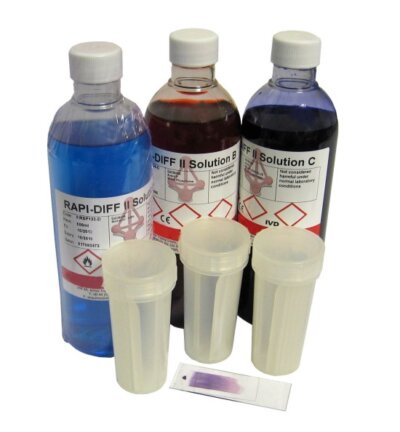
Blood smears used to be a regular veterinary laboratory practice. Despite the domination of automated haematological and cytological analysis, this basic skill still has a place in the modern vet lab.
Well-made blood smear slides are quick, cheap and informative. Making a quality smear begins with a fresh venous blood sample immediately and gently expressed into a veterinary blood tube containing EDTA, heparin, citrate or similar anticoagulant.
Why is cleaning the microscope slide essential?
New, clean microscope slides are essential. Re-used slides have microscopic scratches where blood cells accumulate and residual detergent adversely affecting cell structure and distribution.
Placed one-third of the way along the microscope slide, a droplet 5 to10 microlitre is normally sufficient blood. Held at an angle of about 450 to the first slide, the short edge of a second is placed next to the droplet, and gently drawn back to touch it such that blood spreads along the line of contact between the two slides.
Gently and smoothly pushing the angled slide away from the droplet draws the blood along the first slide, finishing with the angled slide lifted quickly up and away from the now gradually thinning and thumbnail-shaped smear.
How to ensure your blood smear technique is successful
Left to air-dry and fixed with a quick dip into 100% alcohol, the appearance of a ‘feathered edge’, where blood cells are evenly distributed and only one cell thick, will prove the success of your blood smear technique.
Depending on the purpose of the preparation, appropriate staining regimes could now be undertaken to reveal cell morphologies, parasite invasions or disease-related irregularities.
Microscopy, using low power objectives (4X – 10X), will help assess the quality of the preparation and show the best areas for examination with higher power (20X – 40X) objectives. Placing a dry microscope coverslip over the smear will often help to improve visual clarity.
Higher magnification
Where higher magnification is needed, oil immersion objectives (100X) can be used without the need for a mounting medium or coverslip. Oil immersion lenses need careful cleaning, which is why a veterinary microscope like the Vetlab Premiere 260, capable of 1600X magnification – even without oil, is such a desirable instrument.
A simple blood smear slide will often provide sufficient information for diagnostic interpretation, or at least direct the busy veterinary laboratory scientist quickly and cheaply toward the most appropriate course of further analysis.

